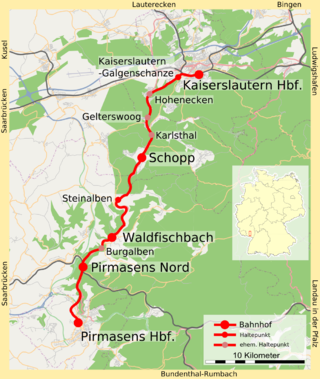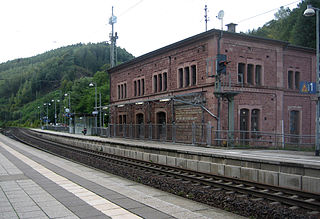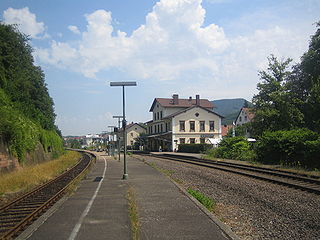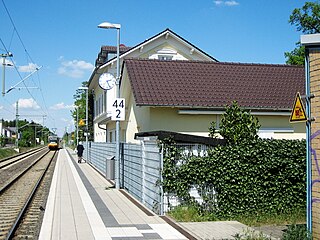
The Mannheim–Saarbrücken railway is a railway in the German states of Baden-Württemberg, Rhineland-Palatinate and the Saarland that runs through Ludwigshafen am Rhein, Neustadt an der Weinstraße, Kaiserslautern, Homburg and St. Ingbert It is the most important railway line that runs through the Palatinate. It serves both passenger and freight transport and carries international traffic.

Neustadt (Weinstr) Hauptbahnhof – called Neustadt a/d. Haardt until 1935 and from 1945 until 1950 – is the central station of in the city of Neustadt in the German state of Rhineland-Palatinate. In addition to the Hauptbahnhof, Rhine-Neckar S-Bahn services stop at Neustadt (Weinstr) Böbig halt (Haltepunkt). Mußbach station and Neustadt (Weinstr) halt, opened on 19 November 2013, are also located in Neustadt.

Landau (Pfalz) Hauptbahnhof is the centre of public transport in the city of Landau in the German state of Rhineland-Palatinate.

The Schifferstadt–Wörth railway or Speyer line is a uniformly double track and electrified main line in the German state of Rhineland-Palatinate. Between Schifferstadt and Germersheim it is part of the network of the Rhine-Neckar S-Bahn. Between Germersheim and Wörth am Rhein it is part of the network of the Stadtbahn Karlsruhe.

Germersheim station is a junction station in the town of Germersheim in the German state of Rhineland-Palatinate. Deutsche Bahn classifies it as a category 5 station and it has four platform tracks. The station is located in the network of the Karlsruher Verkehrsverbund and belongs to fare zone 575. Since 1996, Germersheim has also been part of the area where the tickets of the Verkehrsverbund Rhein-Neckar are accepted at a transitional rate. The address of the station is Bahnhofstraße 13.

The Landau–Rohrbach railway is a major line running from Landau in the German state of Rhineland-Palatinate to Rohrbach in the Saarland. The main section between Landau and Zweibrücken was opened on 25 November 1875 after the first sections had already been opened between 1857 and 1867.

The Biebermühl Railway —sometimes called the Moosalbbahn —is a 35.9 km long railway line from Kaiserslautern to Pirmasens in the German state of Rhineland-Palatinate, which was built between 1875 and 1913. The first section between Biebermühle and Pirmasens connected the city of Pirmasens to the railway network, which could only be achieved via a branch line due to the topography. In 1905, another branch was opened from Biebermühl to Waldfischbach, which was extended in 1913 to Kaiserslautern. It was subsequently used by long-distance services, which operated until 1990. Since then, it has been used only by local services. It is the only one of all the Palatine railway lines that were completed in the 20th century that have never been threatened with closure.

The Dahner Felsenland, also referred to as the Dahn Rockland, is a landscape in the county of Südwestpfalz in the German federal state of Rhineland-Palatinate. It is located in the middle section of the Wasgau, which in turn forms the southern part of the Palatine Forest and the northern part of the Vosges in France. The Dahner Felsenland has numerous rock formations within the South Palatinate Climbing Area.

Landstuhl station is a station in the town of Landstuhl in the German state of Rhineland-Palatinate. Deutsche Bahn classifies it as belonging to station category 3 and has three platforms tracks. The station is located in the network of the Verkehrsverbund Rhein-Neckar (VRN) and belongs to fare zone 844.

The Winden–Karlsruhe railway is a mainline railway in the German states of Baden-Württemberg and Rhineland-Palatinate, which in its present form has existed since 1938 and is electrified between Wörth and Karlsruhe. The current Winden–Wörth section was opened in 1864. A year later, the gap between the Rhine and the Maxau Railway (Maxaubahn), which had been opened in 1862, was closed. The route of the latter was changed during the relocation of the Karlsruhe Hauptbahnhof. New sections of the line were also built between Wörth and Mühlburg mainly in connection with the commissioning of a fixed bridge over the Rhine.

Wörth (Rhein) station—originally Wörth (Pfalz)—is the most important station of the town of Wörth am Rhein in the German state of Rhineland-Palatinate. Deutsche Bahn classifies it as a category 5 station and it has five platforms. The station is located in the area of the Karlsruher Verkehrsverbund and it belongs to fare zone 540. Since 2001, Verkehrsverbund Rhein-Neckar (VRN) tickets are also accepted for travel to or from the VRN area. The address of the station is Bahnhofstraße 44.
Winnweiler station is the station of the town of Winnweiler in the German state of Rhineland-Palatinate. Deutsche Bahn classifies it as a category 6 station and it has two platforms.

Alsenz station is the station of the town of Alsenz in the German state of Rhineland-Palatinate. Deutsche Bahn classifies it as a category 6 station and it has two platforms. Its address is Bahnhofstraße 1.

Frankenstein (Pfalz) station is the station of the town of Frankenstein in the German state of Rhineland-Palatinate. Deutsche Bahn classifies it as a category 6 station and it has two platforms.

Weidenthal station is the station of the town of Weidenthal in the German state of Rhineland-Palatinate. It lies on the Mannheim–Saarbrücken railway, which essentially consists of the Pfälzischen Ludwigsbahn, which historically connected Ludwigshafen and Bexbach. It was opened on 25 August 1849, with the Kaiserslautern–Frankenstein section of the Ludwig Railway. Its entrance building is a protected monument.

Lambrecht (Pfalz) station is the station of the town of Lambrecht in the German state of Rhineland-Palatinate. Deutsche Bahn classifies it as belonging to category 4 and it has three platform tracks. The station is located in the network of the Verkehrsverbund Rhein-Neckar and belongs to fare zone 121. Its address is Bahnhofstraße 4.

Schopp station is a station in the village of Schopp in the German state of Rhineland-Palatinate. Deutsche Bahn classifies it as a category 6 station and it has two platform tracks. The station is located in the network of the Verkehrsverbund Rhein-Neckar and belongs to fare zone 824. Its address is Bahnhofstraße 16.

Annweiler am Trifels station is the main station in the town of Annweiler am Trifels in the German state of Rhineland-Palatinate. Deutsche Bahn classifies it as a category 5 station and it has three platform tracks. The station is located in the network of the Verkehrsverbund Rhein-Neckar and belongs to fare zones 181 and 191. Since 2002, Annweiler has also been part of the area served by the Karlsruher Verkehrsverbund using tickets at a transitional rate. Annweiler was always the most important station between Landau (Pfalz) Hbf and Pirmasens Nord and it used to be served by long-distance services.

Jockgrim station is the only station in the town of Jockgrim in the German state of Rhineland-Palatinate. Deutsche Bahn classifies it as a category 6 station and it has two platform tracks. It is located on the network of the Karlsruher Verkehrsverbund and belongs to fare zone 555. Since 2001, the station has also been part of the area where the fares of the Verkehrsverbund Rhein-Neckar are accepted at a transitional rate. Its address is Am Bahnhof 1.
The Wieslauterbahn - more rarely called the Wasgaubahn, Wieslautertalbahn or Lauterbahn - is a branch line in Rhineland-Palatinate. It branches off from the Landau-Rohrbach line at Hinterweidenthal Ost station and runs via Dahn to Bundenthal-Rumbach. It gained its greatest significance in excursion traffic.



















